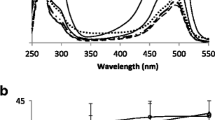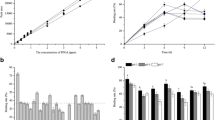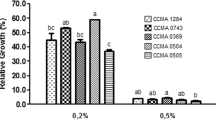Abstract
Introduction
Heterocyclic aromatic amines (HCA) are compounds with high mutagenic potential, formed when meat is cooked at high temperatures of 150–300 °C. These compounds contribute to development of colon and gastric cancer. Western diet provides a lot of HCA and influences the available substrates for the intestinal microbiota which can activate HCA to direct acting mutagens. On the other hand, lactic acid bacteria existing in the colon and ingested with food including probiotics, may exert an anti-carcinogenic action, but the mechanism is still poorly understood.
Materials and methods
In the present study we determined the ability of probiotic Lactobacillus casei DN 114001 (Actimel strain) to metabolise or adsorb three HCA: IQ, MelQx and PhIP in vitro. Lactobacilli were cultivated in MRS and in a modified MRS broth with reduced concentrations of nitrogen and carbon (MRS NC), with addition of 25 μg/ml of IQ, MelQx or PhIP. Their concentration after cultivation with L. casei DN 114001 was measured with high-performance liquid chromatography and the genotoxicity was evaluated by the alkaline comet assay.
Results and conclusions
It was measured, that after 24 h cultivation in MRS (cell density was 109 cfu/ml), rapid decrease of IQ and PhIP (98–99%) was observed, and the peaks on chromatograms were almost completely reduced. In case of MeIQx the decrease was about 27%. In a modified MRS broth (cell density was 108 cfu/ml), the ability to decrease HCA concentration during prolonged cultivation (to 168 h) depended on the growth phase of bacteria, and it was about 51.5% for IQ and at about 11.2% for MeIQx. Non-growing cells (in phosphate buffer), could reduce the content of IQ and PhIP from 72 h to the end of incubation. L. casei DN 114001 reduced genotoxicity of HCA (IQ from 46 to 48%; MeIQx from 35 to 65% and PhIP from 32 to 81%), and the degree depended on the incubation time, cell growth and the medium used. It may suggest that bacteria can metabolise or adsorb HCA.






Similar content being viewed by others
References
Blasiak J, Kowalik J (2000) A comparison of the in vitro genotoxicity of tri- and hexavalent chromium. Mutat Res 649:135–145
Blaut M, Marteau P, Miller GD, Antoine JM (2006) Probiotics and the intestinal microflora: what impact on the immune system, infections and aging? Curr Nutr Food Sci 2:79–95
Blaut M, Clavel T (2007) Metabolic diversity of the intestinal microbiota: implications for health and disease. J Nutr 137:S751–S755
Bolognani F, Rumney CJ, Rowland IR (1997) Influence of carcinogen binding by lactic acid-producing bacteria on tissue distribution and in vivo mutagenicity of dietary carcinogens. Food Chem Toxicol 35:535–545
Burns AJ, Rowland IR (2000) Anti-carcinogenicity of probiotics and prebiotics. Curr Issues Intest Microbiol 1:13–24
Commane D, Hughes R, Shortt C, Rowland IR (2005) The potential mechanisms involved in the anti-carcinogenic action of probiotics. Mutat Res 591:276–289
Cummings JH, Antoine JM, Azpiroz F, Bourdet-Sicard R, Brandtzaeg P, Calder PC, Gibson GR, Guarner F, Isolauri E et al (2004) PASSCLAIM: gut health and immunity. Eur J Nutr 43(2S):118S–173S
de Kok TMCM, van Maanen JMS (2000) Evaluation of faecal mutagenicity and colorectal cancer risk. Mutat Res 463:53–101
Egert M, de Graaf AA, Smidt H, de Vos WM, Venema K (2006) Beyond diversity: functional microbiomics of the human colon. Trends Microbiol 14:86–91
Felton JS, Knize MG, Wu RW, Colvin ME, Hatch FT, Malfatti MA (2007) Mutagenic potency of food-derived heterocyclic amines. Mutat Res 616:90–94
Gutiérrez C, Marco A, Nogales A, Tebar R (2002) Total and segmental colonic transit time and anorectal manometry in children with chronic idiopathic constipation. J Pediatr Gastroenterol Nutr 35:31–38
Harrison JD, Fell TP, Phipps AW, Smith TJ, Ellender M, Ham GJ, Hodgson A, Wilkins BT (2005) Health implications of dounreay fuel fragment: estimates of doses and risks. www.sepa.org.uk/radioactivity
Humbolt C, Combourieu B, Väisänen ML, Furet JP, Delort AM, Rabot S (2005) 1H nuclear magnetic resonance spectroscopy-based studies of the metabolism of food-borne carcinogen 2-amino-3-methylimidazo[4, 5-f]quinoline by human intestinal microbiota. Appl Environ Microbiol 71:5116–5123
Husni-Hag-Ali R, Gomez-Rodriguez BJ, Mendoza Olivares FJ, Garcia Montes JM, Sachez-Gey Venegas S, Herrerias Gutierrez JM (2003) Measuring colonic transit time in chronic idiopathic constipation. Rev Esp Enferm Dig 95:186–190
Isolauri E (2004) Probiotics. Best Pract Res Clin Gastroenterol 18:299–313
Kassie F, Lhoste EF, Bruneau A, Zsivkovits M, Ferk F, Uhl M, Zidek T, Knasmuller S (2004) Effect of intestinal microflora from vegetarians and meat eaters on the genotoxicity of 2-amino-3-methylimidazo[4, 5-f]quinoline, a carcinogenic heterocyclic amine. J Chromatogr B 802:211–215
Keating GA, Layton DW, Felton J (1999) Factors determining dietary intakes of heterocyclic aromatic amines in cooked foods. Mutat Res 443:149–156
Klaude M, Eriksson S, Nygren J, Ahnstrom G (1996) The comet assay: mechanisms and technical consideration. Mutat Res 363:89–96
Kobayashi M, Hanaoka T, Tsugane S (2007) Validity of a self-administrated food frequency questionnaire in the assessment of heterocyclic amine intake using 2-amino-1-methyl1–6-phenylimidazo[4, 5-b]pyridine (PhIP) levels in hair. Mutat Res 630:14–19
Lankaputhra WEV, Shah NP (1998) Antimutagenic properties of probiotic bacteria and of organic acids. Mutat Res 397:169–182
Layton DW, Bogen KT, Knize MG, Hatch FT, Johnson VM, Felton JS (1995) Cancer risk of heterocyclic amines in cooked foods: an analysis and implications for research. Carcinogenesis 16(1):39–52
Limdi JK, O’Neill C, McLaughlin J (2006) Do probiotics have a therapeutic role in gastroenterology? World J Gastroenterol 12(34):5447–5457
Murkovic M (2007) Analysis of heterocyclic aromatic amines. Anal Bioanal Chem (in press). doi: 10.1007/s00216-007-1306-z
Nakagama H, Ochiai M, Ubagai T, Tajima R, Fujiwara K, Sugimura T, Nagao M (2002) A rat colon cancer model induced by 2-amino-1-methyl-6-phenylimidazo[4, 5-b]pyridine, PhIP. Mutat Res 506–507:137–144
Oba S, Shimizu N, Nagata C, Shimizu H, Kametani M, Takeyama N, Ohnuma T, Matsushita S (2006) The relationship between the consumption of meat, fat, coffee and risk of colon cancer: a perspective study in Japan. Cancer Lett 244:260–267
O’Keefe SJD, Chung D, Mahmound N, Sepulveda AR, Manafe M, Arch J, Adada H, ban der Melve T (2007) Why do African Americans get more colon cancer than native Africans? J Nutr 137:175S–182S
O’Hara AM, Shanahan F (2007) Gut microbiota: mining for therapeutic potential. Clin Gastroenterol Hepatol 5:274–284
Orrhage K, Sillerstrom E, Gustafsson JA, Nord CE, Rafter J (1994) Binding of heterocyclic amines by intestinal and lactic acid bacteria. Mutat Res 1:239–248
Salmon CP, Knize MG, Felton JS, Zhao B, Seow A (2006) Heterocyclic aromatic amines in domestically prepared chicken and fish from Singapore Chinese households. Food Chem Toxicol 44:484–492
Shin A, Shrubsole MJ, Ness RM, Wu H, Sinha R, Smalley WE, Shyr Y, Zheng W (2007) Meat and meat-mutagen intake, doneness preference and the risk of colorectal polyps: the Tennessee Colorectal Polyp Study. Int J Cancer 121:136–142
Sinha R, Rothman N, Salmon CP, Knize MG, Brown ED, Swanson CA, Rhodes D, Rossi S, Felton JS, Levander OA (1998) Heterocyclic amines content in beef cooked by different methods to varying degrees of doneness and gravy made from meat drippings. Food Chem Toxicol 36:279–287
Singh NP, McCoy M, Tice RR, Schneider EL (1988) A simple technique for quantitation of low levels of DNA damage in individual cells. Exp Cell Res 175:184–191
Sreekumar O, Hosono A (1998) The heterocyclic amine binding receptors of Lactobacillus gasseri cells. Mutat Res 421:65–72
Terahara M, Meguro S, Kaneko T (1998) Effects of lactic acid bacteria on binding and absorption of mutagenic heterocyclic amines. Biosci Biotechnol Biochem 62:197–200
Terry PD, Lagergren J, Wolk A, Steineck G, Nyren O, Rothman N (2003) Dietary intake of heterocyclic amines and cancers of the oesophagus and gastric cardia. J Womens Health 12:173–182
Toribio F, Busquets R, Puignou L, Galceran MT (2007) Heterocyclic aromatic amines in griddled beef steak analysed using a single extract clean-up procedure. Food Chem Toxicol 45:667–675
Turesky RJ (2007) Formation and biochemistry of carcinogenic heterocyclic aromatic amines in cooked meats. Toxicol Lett 168:219–227
Vanhaecke L, Verstraete W, Van de Wiele T (2006) Metabolism of the food associated carcinogen 2-amino-1-methyl-6-phenylimidazo[4, 5-b]pyridine by human intestinal microbiota. Reprod Nutr Dev 46(1S):S1–S138
Vanhaecke L, Van Hoof N, Van Brabandt W, Soenen B, Heyerick A, De Kimpe N, De Keukeleire D, Verstraete W, Van de Wiele T (2006) Metabolism of the food associated carcinogen 2-amino-1-methyl-6-phenylimidazo[4, 5-b]pyridine by human intestinal microbiota. J Agric Food Chem 54:3454–3461
Van Tassell RL, Kingston DGI, Wilkins TD (1990) Metabolism of dietary genotoxins by the human colonic microflora: the fecapentaenes and heterocyclic amines. Mutat Res 238:209–221
Wu K, Giovannucci E, Byrne C, Platz EA, Fuchs C, Willett WC, Sinha R (2006) Meat mutagens and risk of distal colon adenoma in cohort of U.S. men. Cancer Epidemiol Biomarkers Prev 15:1120–1125
Yang CC, Jenq SN, Lee H (1998) Characterization of the carcinogen 2-amino-3, 8-dimethylimidazo[4, 5-f]quinoxaline in cooking aerosols under domestic conditions. Carcinogenesis 19:359–363
Zhang XB, Ohta Y (1993) Antimutagenicity of cell fractions of microorganisms on potent mutagenic pyrolysates. Mutat Res 298:247–253
Zoetendal EG, Vaughan EE, de Vos WM (2006) A microbial world within us. Mol Microbiol 59:1639–1650
Acknowledgment
The comet assay was conducted with the help of Professor Janusz Blasiak from the Department of Molecular Genetics at the University of Lodz in Poland.
Author information
Authors and Affiliations
Corresponding author
Rights and permissions
About this article
Cite this article
Nowak, A., Libudzisz, Z. Ability of probiotic Lactobacillus casei DN 114001 to bind or/and metabolise heterocyclic aromatic amines in vitro. Eur J Nutr 48, 419–427 (2009). https://doi.org/10.1007/s00394-009-0030-1
Received:
Accepted:
Published:
Issue Date:
DOI: https://doi.org/10.1007/s00394-009-0030-1




